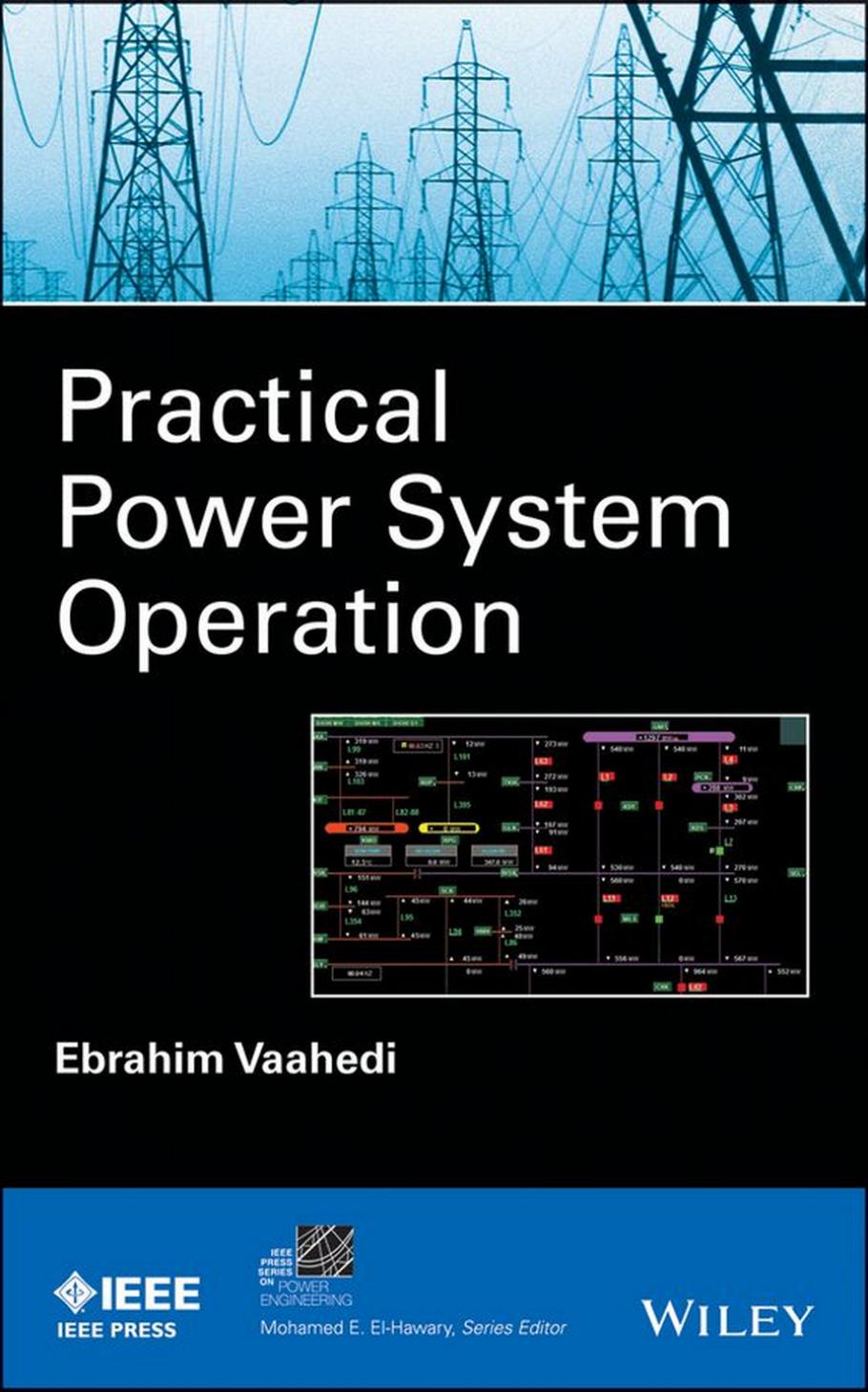Practical Power System Operation 2014 1st edition by Ebrahim Vaahedi ISBN 1118848527 9781118848524
$70.00 Original price was: $70.00.$35.00Current price is: $35.00.
Instant download Practical Power System Operation 2014 after payment
Practical Power System Operation 2014 1st edition by Ebrahim Vaahedi – Ebook PDF Instant Download/Delivery: 1118848527, 9781118848524
Full download Practical Power System Operation 2014 1st edition after payment

Product details:
ISBN 10: 1118848527
ISBN 13: 9781118848524
Author: Ebrahim Vaahedi
Undergraduate and post graduate students in the power system area as well as other professionals in electric utilities, independent system operators (ISO), consulting companies, electricity regulators and all other entities dealing with system operation
Practical Power System Operation 2014 1st Table of contents:
Chapter 1 INTRODUCTION
1.1 OVERVIEW OF POWER SYSTEM OPERATION
1.2 OPERATOR
1.3 PROCESS
1.4 TECHNOLOGY
1.5 POWER SYSTEM OPERATION CRITERIA
1.6 OUTLINE OF THE BOOK
Chapter 2 POWER SYSTEM MONITORING
2.1 OPERATOR FUNCTION IN POWER SYSTEM MONITORING
2.2 PROCESS FOR POWER SYSTEM MONITORING
2.3 TECHNOLOGY FOR POWER SYSTEM MONITORING
2.3.1 The Role of System Control and Data Acquisition (SCADA)
2.3.2 State Estimation
2.3.3 Least Square Method for State Estimation
2.4 BAD DATA IDENTIFICATION
2.5 OBSERVABILITY
Questions and Problems
Chapter 3 POWER SYSTEM SCENARIO ANALYSIS
3.1 OPERATOR FUNCTION IN POWER SYSTEM SCENARIO ANALYSIS
3.2 PROCESS FOR POWER SYSTEM SCENARIO ANALYSIS
3.3 TECHNOLOGY FOR POWER SYSTEM CONTROL
3.3.1 Infrastructure for Power System Control
3.3.2 Technology for Power System Scenario Analysis: Power Flow
3.3.3 System Modeling
3.3.4 Power Flow Techniques
3.3.5 Factorization
3.3.6 Sparsity
3.3.7 Different Power Flow Scenarios and Applications
Questions and Problems
Chapter 4 POWER SYSTEM POSTURING: STATIC SECURITY
4.1 OPERATOR’s QUESTION ON POWER SYSTEM POSTURING: STATIC SECURITY
4.2 PROCESS FOR POWER SYSTEM POSTURING: STATIC SECURITY
4.3 TECHNOLOGY FOR POWER SYSTEM POSTURING: STATIC SECURITY
4.3.1 Contingency Analysis
4.3.2 Contingency Definition
4.3.3 Contingency Selection
4.3.4 Contingency Evaluation
4.3.5 Implementation of Remedial Action Schemes
Questions and Problems
Chapter 5 POWER SYSTEM POSTURING: ANGULAR STABILITY
5.1 OPERATOR’s QUESTION ON POWER SYSTEM POSTURING: ANGULAR STABILITY
5.2 PROCESS FOR POWER SYSTEM POSTURING: aNGULAR STABILITY
5.3 TECHNOLOGY FOR POWER SYSTEM POSTURING: ANGULAR STABILITY
5.3.1 Angular Stability Assessment
5.3.2 Power System Stability
5.3.3 Angular Stability
5.3.4 Transient Stability
5.3.5 Small System
5.3.6 Integration Methods
5.3.7 Equal-Area Criteria Method
5.3.8 Models for Other Components
5.3.9 Multimachine System
5.3.10 Small-Signal Stability
5.3.11 Angular Stability Limit Derivation
5.4 IMPLEMENTATION OF ANGULAR STABILITY LIMITS
Questions and Problems
Chapter 6 POWER SYSTEM POSTURING: VOLTAGE STABILITY
6.1 OPERATOR’s QUESTION ON POWER SYSTEM POSTURING: VOLTAGE STABILITY
6.2 PROCESS FOR POWER SYSTEM POSTURING: VOLTAGE STABILITY
6.3 TECHNOLOGY FOR POWER SYSTEM POSTURING: VOLTAGE STABILITY
6.3.1 Voltage Stability Assessment
6.4 VOLTAGE STABILITY LIMIT DERIVATION AND IMPLEMENTATION
6.4.1 Voltage Stability Limit Derivation
6.4.2 Implementation of Voltage Stability Limits
Questions and Problems
Chapter 7 POWER SYSTEM GENERATION LOAD BALANCE
7.1 OPERATOR’S QUESTION ON GENERATION LOAD BALANCE
7.2 PROCESS FOR GENERATION LOAD BALANCE
7.2.1 Introduction
7.2.2 NERC Standards for Automatic Generation Control
7.2.3 Process for Automatic Generation Control
7.3 TECHNOLOGY FOR GENERATION LOAD BALANCE
7.3.1 Automatic Generation Control Application
7.3.2 Automatic Generation Control Infrastructure
7.3.3 Example on AGC Operation
Questions and Problems
Chapter 8 POWER SYSTEM OPERATION OPTIMIZATION
8.2 PROCESS FOR POWER SYSTEM GENERATION OPERATION
8.2.1 Introduction
8.2.2 Utility Model
8.3 PROCESS FOR GENERATION SUFFICIENCY
8.3.1 Generation Sufficiency Process for Operations Planning
8.3.2 Generation Sufficiency Process for Near Real Time
8.3.3 Generation Sufficiency Process for Real Time
8.4 TECHNOLOGY FOR GENERATION SUFFICIENCY
8.4.1 Generation Sufficiency Applications
8.4.2 Generation Sufficiency Infrastructure
Questions and Problems
Chapter 10 ENERGY MANAGEMENT SYSTEMS
10.1 INTRODUCTION
10.2 EMS FUNCTIONALITY OVERVIEW
10.2.1 System Monitoring
10.2.2 Decision Support Systems
10.2.3 EMS Control Actions
10.3 ENERGY MANAGEMENT SYSTEM AVAILABILITY CRITERIA AND ARCHITECTURE
10.3.1 Hardware Overview
10.3.2 Software Overview
10.3.3 Application Sequencing in EMS
10.3.4 Software Integration
Questions and Problems
Chapter 11 DISTRIBUTION MANAGEMENT SYSTEM
11.1 INTRODUCTION
11.2 DMS FUNCTIONALITY OVERVIEW
11.2.1 System Monitoring
11.2.2 Decision Support Systems
11.2.3 DMS Control Actions
11.3 DISTRIBUTION MANAGEMENT SYSTEM ARCHITECTURE
11.3.1 Hardware Overview
11.3.2 Software Overview
11.3.3 Application Integration with DMS
Questions and Problems
Chapter 12 EVOLVING POWER SYSTEM OPERATION SOLUTIONS
12.1 INTRODUCTION
12.2 EVOLVING OPERATION SOLUTIONS
12.2.1 Online Transient Stability
12.2.2 Online Voltage Stability
12.2.3 Total Transfer Capability Calculator
12.2.4 Transmission Outage Scheduling System
12.2.5 Synchrophasor Systems
12.2.6 Distribution Automation
12.2.7 Dynamic Thermal Rating Systems
12.2.8 Distributed Energy Resources
12.2.9 Demand Response
12.2.10 Microgrid
12.2.11 Real-Time Posturing and Control
12.2.12 Critical System Application and Facilities Heartbeat
12.2.13 Probabilistic Limit Calculations
12.2.14 Managing Critical Operations Knowledge: Operations Code Book
Appendix A PRELIMINARY CONCEPTS
A.1 INTRODUCTION
A.2 PHASOR REPRESENTATION
A.3 PER-UNIT REPRESENTATION
A.4 MATRIX ALGEBRA
A.5 STEADY-STATE COMPONENT MODELING
A.5.1 Transmission Lines
A.5.2 Transformers and Phase Shifters
A.5.3 Generators
A.5.4 Shunts and Synchronous Condensers
A.5.5 Loads
A.5.6 Network Equations
References
Index
People also search for Practical Power System Operation 2014 1st:
practical power system operation
practical power system operation first edition author ebrahim vaahedi
practical power system operation pdf
practical power system protection pdf
practical powers
Tags: Ebrahim Vaahedi, Practical Power, System Operation


